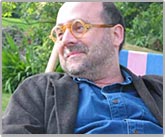
Kenneth Caldwell
Photo: Paul Crabtree
|
|
 |
From One Room Out to the World
By Kenneth Caldwell
Several years ago I interviewed Lian Hurst Mann about the social project of architecture for Architecture California. That experience led to an ongoing discussion (mostly in my head) about the architect's role within an economic and political context. For me, the interview raised questions that I still struggle to answer. What can one architect do that makes a difference? Earlier this year I attended the reopening party at San Francisco's Ronald McDonald House, where several architects and designers had volunteered to redesign the rooms and refurnish them at their own expense. I was (profoundly) moved that in the midst of a recession, firms and their staff would step forward to help families of children in need, and once again, I was reminded that design professionals want to make a difference. It was time to return to the nagging question. How do architects understand their work in the context of social responsibility and how do they address it?
By sharing different stories from across the broad spectrum of social involvement, this issue of LINE looks at the idea of socially responsible architecture and shows how some architects work to improve the social condition. Some architects choose political action or teaching, some try to connect their everyday work to a sociopolitical idea, and others pursue altruistic activities quite apart from practice.
Two writers address the larger philosophical/ideological issues: Pierluigi Serraino has taken on the difficult task of placing the concept of "socially responsible architecture" in a historical context, and John Parman explores three strands of contemporary thinking about the topic. To examine how social responsibility translates to daily practice, we have profiled a variety of firms. Herman & Coliver: Architecture, for instance, works exclusively for nonprofit organizations, while a large corporate firm like Gensler finds a number of ways to address the need to do good. Tim Culvahouse and John Peterson suggest that every firm commit 1% of its efforts to socially responsible work, and architects Cameron Sinclair and Lisa Findley discuss how they are working outside regular practice to see their dreams realized.
Voices from outside the Bay Area include David Sokol, who links the World Trade Center design tale to social responsibility, and Andrea Dean, who remembers Sam Mockbee and his work at Rural Studio. Enrique Norten, one of the most respected architects practicing today, concedes in an interview that it is hard for architects to resist globalization in political terms, yet he believes they can still speak through their work.
With the current economic and political situation, it is difficult to be hopeful. But there are architects (and yes, developers too!) who are interested in building sustainable, infill, transit-based, and affordable projects. These successful projects, developer Tom Sargent suggests in his interview, provide models that can be replicated. At the Monterey Design Conference, University of Cape Town Professor David Dewar reminded us that most people in the world do not enjoy our standard of living, and showed how much can be accomplished with political will, modest resources, and good planning and design. Let us recommit ourselves to finding ways for architecture to do more. Rose McNulty from Asian Neighborhood Design points out that architects should be initiators and not reactors. Whether it is one room, one clinic, one city, or an entire political economic structure, we can engage creatively and effectively; the tools are at our fingertips.
Kenneth Caldwell is a communications consultant and writer based in Oakland, California.
|